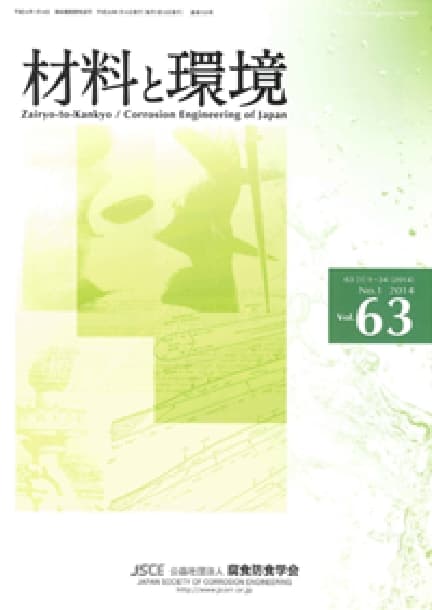材料と環境 Vol. 59 (2010), No. 2
Backnumber
-
Vol. 74 (2025)
-
Vol. 73 (2024)
-
Vol. 72 (2023)
-
Vol. 71 (2022)
-
Vol. 70 (2021)
-
Vol. 69 (2020)
-
Vol. 68 (2019)
-
Vol. 67 (2018)
-
Vol. 66 (2017)
-
Vol. 65 (2016)
-
Vol. 64 (2015)
-
Vol. 63 (2014)
-
Vol. 62 (2013)
-
Vol. 61 (2012)
-
Vol. 60 (2011)
-
Vol. 59 (2010)
-
Vol. 58 (2009)
-
Vol. 57 (2008)
-
Vol. 56 (2007)
-
Vol. 55 (2006)
-
Vol. 54 (2005)
-
Vol. 53 (2004)
-
Vol. 52 (2003)
-
Vol. 51 (2002)
-
Vol. 50 (2001)
-
Vol. 49 (2000)
-
Vol. 48 (1999)
-
Vol. 47 (1998)
-
Vol. 46 (1997)
-
Vol. 45 (1996)
-
Vol. 44 (1995)
-
Vol. 43 (1994)
-
Vol. 42 (1993)
-
Vol. 41 (1992)
-
Vol. 40 (1991)
キーワードランキング
13 Dec. (Last 30 Days)
材料と環境 Vol. 59 (2010), No. 2
淡水中における耐脱亜鉛腐食黄銅の溶解反応機構と耐食性
板垣 昌幸, 芦江 伸之, 本田 英靖, 萩原 光一, 上坂 美治, 木皿儀 隆康
pp. 43-49
DOI:
10.3323/jcorr.59.43抄録
Polarization curves of brass, dezincing-resistant brass and bronze were measured by channel flow double electrode (CFDE), and the electrochemical property of dezincing-resistant brass was investigated. By using CFDE, Cu(I) and Cu(II) ions dissolved from the copper-alloy electrode can be determined simultaneously during the measurement of polarization curve. The anodic polarization curve of brass was divided into two potential regions, namely, selective dissolution of zinc below 0 V vs. SSE (region I) and both dissolutions of copper and zinc above 0 V vs. SSE (region II). In the case of anodic polarization curve of dezincing-resistant brass ranked as type I by JBMA T303 test, the current was small in the region I, and the dissolution ratio of zinc was small in the region II. On the other hand, the corrosion test under the fresh water flow was carried out for brass, dezincing-resistant brass, bronze and SUS316. As the result, the dissolution morphology of dezincing-resistant brass ranked as type I tended to general corrosion even in the case that the brass showed the dezincing corrosion. In addition, the short circuit between the dezincing-resistant brass ranked as type I and SUS316 didn’t show galvanic corrosion since the corrosion potential of the dezincing-resistant brass ranked as type I is closed to that of SUS316 in the present test water.
論文アクセスランキング
13 Dec. (Last 30 Days)
-
大気腐食環境下における1700 MPa級調質ボルトの遅れ破壊機構
鉄と鋼 早期公開
-
Perspectives on the Promising Pathways to Zero Carbon Emissions in the Steel Industry toward 2050
ISIJ International Vol.65(2025), No.2
-
-
Factors Influencing the Bonding Phase Structure of Iron Ore Sinters
ISIJ International Vol.43(2003), No.9
-
-
-
Progress of Strip Casting Technology for Steel; Historical Developments
ISIJ International Vol.52(2012), No.12
-
Research Progress on Optimal Blending of Iron Ore Powders for Sintering
ISIJ International Vol.65(2025), No.12
-
-
Microstructures and Reduction Properties of High CaO Concentration Sintered Ore
ISIJ International 早期公開
この機能はログイン後に利用できます。
下のボタンをクリックしてください。










